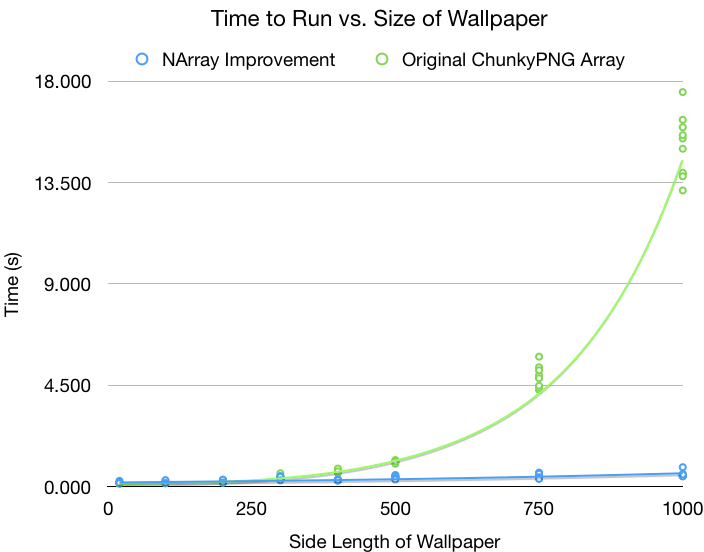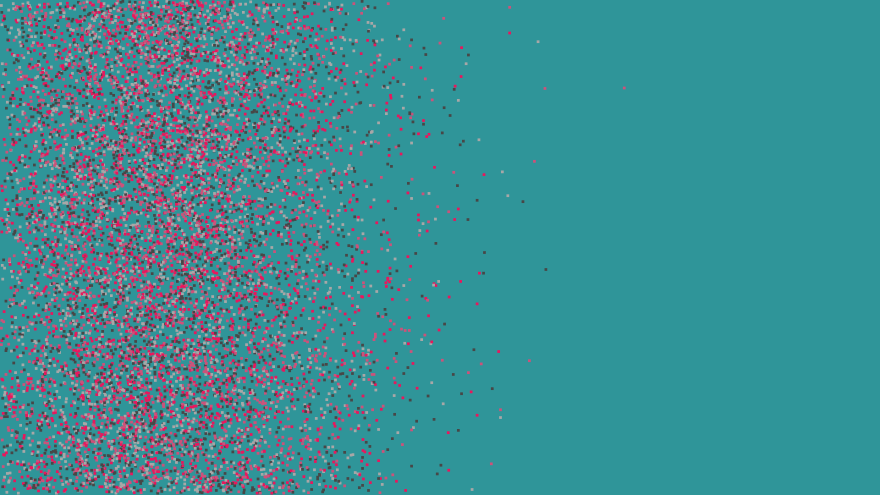This post was originally published on my website. Check it out for more awesome content!
Earlier this week, I had released Virgo, a Ruby CLI to generate wallpapers (including the one above). My goal was to be able to create beautiful OLED wallpapers for my phone, but unfortunately, the first version of Virgo would take about 15 seconds to generate a wallpaper the size of an iPhone 11. The first version of Virgo used ChunkyPNG::Image to place pixels on the background, and the author of ChunkyPNG alludes to this possible problem in his README:
Also, have a look at OilyPNG which is a mixin module that implements some of the ChunkyPNG algorithms in C, which provides a massive speed boost to encoding and decoding.
Improvement Goal
My goal was to reduce the time to generate an iPhone-sized wallpaper (about 1200 by 2200 pixels) in under one second. I chose this constraint so that I can eventually write a web frontend in Sinatra. Users won’t wait 15 seconds for an image to be generated, especially if the file is being provided by a server without any loading indication on the page.
Thinking of a Solution
When thinking of optimization ideas, two options stood out to me from Willem’s README:
- Can I adapt Virgo to use OilyPNG instead of ChunkyPNG?
- Is there another library that implements array manipulation in C?
After some research into OilyPNG, I found that the functions I used with ChunkyPNG weren’t implemented in OilyPNG1, so I was left to find another library that enabled a faster manipulation of integer arrays. I knew that in the Python world, NumPy would be the immediate answer. After some research for a Ruby alternative to NumPy, I came across NArray, which appeared to be a solution others had relied on in the past. I alluded to this possible approach in my original post:
ChunkyPNG was used to manage and save the wallpaper images, and Commander enabled terminal argument parsing and help documentation. For optimization, I plan to use NArray for creating the pixel locations in the wallpaper and writing a custom PNG encoder.
Fast Pixel Placement
After some profiling, the section of code that could be improved the most was overlaying pixels on the background image:
def place_pixel
# Create a new canvas
pixel = Image.new(@pixel_diameter, @pixel_diameter, @theme.foreground)
# Replace the old image with the new canvas at the pixel coordinate
@image = @image.replace(pixel, pixel_coordinate.x, pixel_coordinate.y)
end
Rather than creating new ChunkyPNG::Images and overlaying them on a master Image, I decided to use a new data structure for the image. Instead, Virgo now uses an NArray to represent the image, where each item is the Integer representation of the pixel ChunkyPNG::Color. For every pixel, a portion of the array is replaced with the integer color:
def create_map
# Start with each pixel in the image as the background color
map = NArray.int(@width, @height).fill!(@theme.background)
# Place each pixel in the map
count = number_pixels_to_place
(1..count).each do
# Determine pixel location
x = @x_distribution.random_point
x_max = x + @pixel_diameter
y = @y_distribution.random_point
y_max = y + @pixel_diameter
# Replace the pixel in the map with a new (random) color
map[x..x_max, y..y_max] = @theme.random_foreground
end
end
Then, to create save a Wallpaper instance, a ChunkyPNG::Image is created by inserting rows of the NArray into the Image:
def image
img = Image.new(@width, @height, Color::TRANSPARENT)
# Put each row of @map into the image
num_rows = @map.shape[1]
(0...num_rows).each do |row_idx|
# Replace the row in the image with the new colors
img.replace_row!(row_idx, @map[true, row_idx])
end
img
end
int vs Integer
There was only one problem with this solution: the range of values for ChunkyPNG::Image would often exceed the range of the int type used by NArray. Therefore, most of the colors in the predefined themes could not be placed into the color map as-is.
I decided to implement a color hash (enum) for a Theme instance, where every key is a unique (low Integer value identifier), and each value is the (large Integer) ChunkyPNG::Image value. The background color (@background) will always have the identifier 0, and the foreground colors (@foregrounds) have identifiers from 1 to n. The color hash is created in Theme.initialize:
def initialize(background = BACKGROUNDS[:black],
foregrounds = FOREGROUNDS[:ruby])
@background = Color.from_hex(background)
@foregrounds = foregrounds.map { |x| Color.from_hex(x) }
# Because NArray can't handle the size of some ChunkyPNG::Color
# values, create a Hash of the background and foreground colors,
# where the key of the hash is an Integer, and the
# value is the value of the color
# Background has a key of 0, foregrounds have keys from 1..n
colors = [@background] + @foregrounds
colors_with_indices = colors.each_with_index.map do |color, idx|
[idx, color]
end
@color_hash = Hash[colors_with_indices]
end
Let’s look at an example:
2.6.3 :001 > # Construct a theme using predefined color names
2.6.3 :002 > t = Theme.from_syms(:black, :ruby)
=> #<Theme:0x00007f861f8c2128
@background=255,
@foregrounds=[
2367954943,
2720605439,
3073321215,
3425971711,
3561307903,
3646510079,
3731712255],
@color_hash={
0=>255,
1=>2367954943,
2=>2720605439,
3=>3073321215,
4=>3425971711,
5=>3561307903,
6=>3646510079,
7=>3731712255}>
Note that the @background color 255 is in @color_hash as 0=>255, which means it has an identifier of 0. The second color in @foregrounds, 2720605439, is in @color_hash as 2=>2720605439, meaning that color has an identifier of 2.
Therefore, if the Wallpaper map has the following values:
[[0, 0, 0],
[0, 2, 0],
[0, 0, 0] ]
Then the middle pixel is red (a value of 2720605439), and the border pixels are black (a value of 255).
Next, we add a few helper functions to Theme for retrieving a random foreground (pixel) color and color keys/values:
# Returns the key for the background color
def background_key
# The background always has a key of 0
0
end
# Returns a random @color_hash foreground key
def random_foreground_key
# (Slightly) speed up getting a foreground by returning the first
# item if only one exists
color = if @foregrounds.length == 1
@foregrounds[0]
else
@foregrounds.sample
end
key_from_color(color)
end
# Returns the ChunkyPNG::Color value for a color key
def color_from_key(key)
@color_hash[key]
end
# Returns the key (in @color_hash) for a color value
def key_from_color(color)
@color_hash.key(color)
end
And create_map is updated to use the color keys rather than the large values:
def create_map
# Start with each pixel in the image as the background color
map = NArray.int(@width, @height).fill!(@theme.background_key)
# Place each pixel in the map
count = number_pixels_to_place
(1..count).each do
# Determine pixel location
x = @x_distribution.random_point
x_max = x + @pixel_diameter
y = @y_distribution.random_point
y_max = y + @pixel_diameter
# Replace the pixel in the map with a new (random) color
map[x..x_max, y..y_max] = @theme.random_foreground_key
end
map
end
Now we can test whether using NArray vs ChunkyPNG::Image reduced the time to generate large wallpapers.
Results
Using NArray significantly improved Virgo’s speed:
Note the exponential time complexity of the original implementation, and the linear time complexity.2 With 10 trials, NArray Virgo took 0.5 seconds on average to generate a 1000x1000 wallpaper, while the original implementation of Virgo takes 15.1 seconds on average. That’s a a 30x improvement! Even better, these updates will allow me to make a responsive Sinatra web frontend, without worrying about user retention or delays.
Future Improvements
I believe more improvements could be made to Virgo, especially since I plan on writing a web frontend. In particular, I’ve added a Distribution class to enable both normal and uniform pixel distributions, but I have not added it as a feature to the CLI. Further, there is a new version of NArray called Numo::NArray that supports UInt64 values, so there will no longer be a need to map each color in a Theme to unique identifiers.
Virgo is available on my GitHub profile, and it’s open to pull requests!
In fact, the library didn’t seem to have implemented much, if any, of the ChunkyPNG functionality. ↩
Well, O(n) at least comparative to the ChunkyPNG implementation and tests I conducted up to an image size of 5000x5000. ↩









Top comments (0)